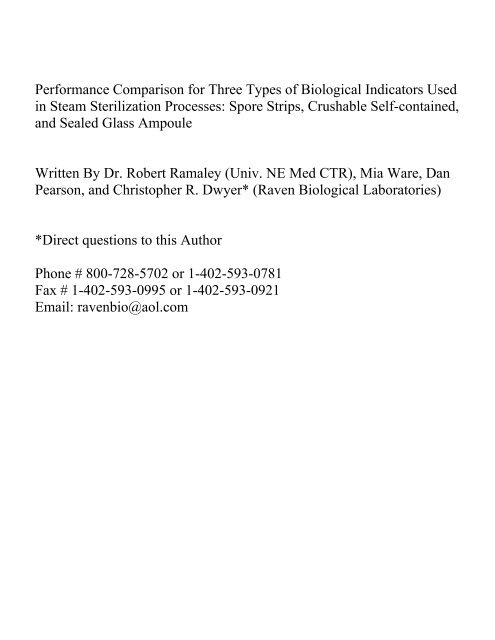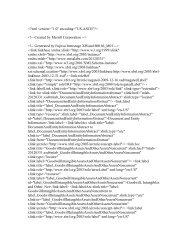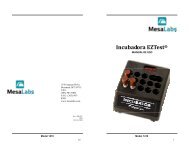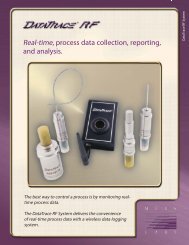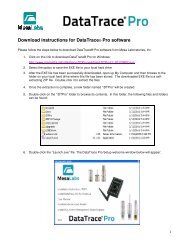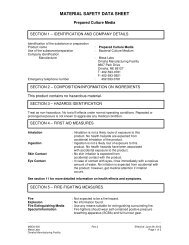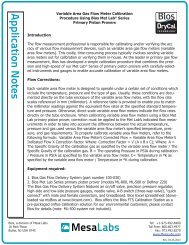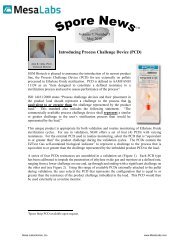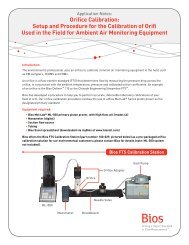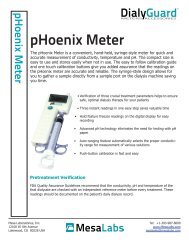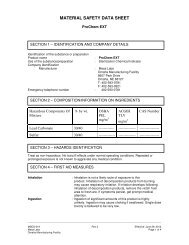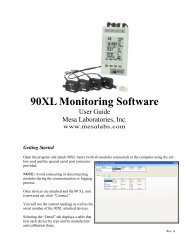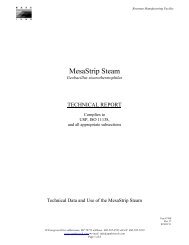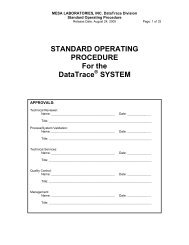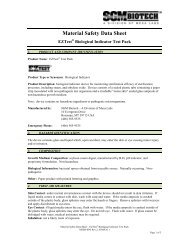Create successful ePaper yourself
Turn your PDF publications into a flip-book with our unique Google optimized e-Paper software.
Performance Comparison for Three Types of Biological Indicators Used<br />
in Steam Sterilization Processes: <strong>Spore</strong> Strips, Crushable Self-contained,<br />
and Sealed Glass Ampoule<br />
Written By Dr. Robert Ramaley (Univ. NE Med CTR), Mia Ware, Dan<br />
Pearson, and Christopher R. Dwyer* (Raven Biological Laboratories)<br />
*Direct questions to this Author<br />
Phone # 800-728-5702 or 1-402-593-0781<br />
Fax # 1-402-593-0995 or 1-402-593-0921<br />
Email: ravenbio@aol.com
Regulatory officials and sterilization experts have voiced concerns regarding the<br />
appropriateness of using a Biological Indicator (BI) Ampoule interchangeably with spore<br />
strips or other approved self-contained Biological Indicators (BIs). They argued spores in a<br />
sealed glass ampoule do not have direct contact with the steam, and this lack of direct contact<br />
with the sterilant caused the Ampoule to behave differently than other types of BIs. There<br />
was no scientific data to support this argument, only the belief that since the spores do not<br />
have direct contact with the steam, the Ampoule should not be used in porous load cycles<br />
because a “poor quality steam environment” might not be detected by the Ampoule. This<br />
argument disregards the fact that the Ampoule BIs are tested for population, Dvalue and<br />
Zvalue by the same standardized methods and equipment that are used to test other BIs. The<br />
following report will describe various tests and data collected to determine if the Ampoule BI<br />
behaves equivalently to spore strips and other self-contained BIs.<br />
Background: Biological Indicators (BIs) are used to determine whether a sterilizer has<br />
delivered a lethal cycle. Evaluation of resistant, spore-forming microorganisms processed<br />
through steam cycles gives the operator a direct measurement of the lethality delivered by the<br />
sterilizer during that particular cycle. The organisms used are of known quantity<br />
(population) and resistance (Dvalue). The organisms are packaged in such a way as to allow
the sterilant access to the spores, and allow for either enumeration or recovery of surviving<br />
organisms. Following are three packaging configurations for Bis used in steam cycles:<br />
1) <strong>Spore</strong> Strip - spores are inoculated onto filter paper and then packaged in a glassine paper<br />
pouch or envelope. The glassine paper allows the penetration of sterilant, and it also<br />
keeps the strip from being contaminated after the sterilization cycle. After exposure in the<br />
sterilizer, the spore strip is transferred from the glassine into a test tube of recovery<br />
medium and incubated to check for sterility.<br />
2) Self-contained with a media ampoule separate from the spores (e.g. Attest, Prospore2,<br />
Verify) - <strong>Spore</strong>s are inoculated onto filter paper. The filter paper is placed into a plastic<br />
tube along with a sealed glass ampoule containing the recovery media. The tube is then<br />
capped, but the cap must allow direct penetration of sterilant. After exposure in a<br />
sterilizer, the glass ampoule containing media is crushed to activate the unit (allowing the<br />
spores access to the recovery media) and incubated to check for sterility.<br />
3) BI Ampoules typically are a one (1) to four (4) ml sealed glass ampoule containing spores<br />
suspended within recovery media. After the ampoule is filled it is hermetically sealed.<br />
This type of BI requires no activation, and the transfer step associated with spore strips is<br />
eliminated. As steam condenses on the glass, the energy from the steam is transferred<br />
across the glass to the liquid media within the ampoule. Temperature and pressure within<br />
the ampoule rise, creating a micro-environment similar to that outside the Ampoule,<br />
leading to spore death. After the cycle the ampoule is incubated to check for sterility.
MATERIALS:<br />
� <strong>Spore</strong> Strips and Prospore Ampoules manufactured by Raven Biological Laboratories, and<br />
Attest Biological Indicators for Steam manufactured by 3M. All BIs used contained B.<br />
stearothermophilus spores (ATCC # 7953). Specifications for the BIs used are available<br />
in Figure 4.<br />
� Joslyn BIER (Biological Indicator Evaluator Resistometer) Vessel<br />
� Amsco Based Steam Sterilizer modified to perform air removal testing by introducing a<br />
measured “LEAK” of air into the chamber.<br />
� 16 Towel Test Packs constructed according to AAMI Good Hospital Practice: Steam<br />
Sterilization and Sterility Assurance; section 7.6.1<br />
� Baxter Constant Temperature Oven<br />
� Intergraph Chemical Integrators - performance specification: complete color change at 3.5<br />
minutes @ 134 0 C<br />
� Cross Checks Chemical Integrators<br />
� USP 23 (supplement 5) Viable <strong>Spore</strong> Count Procedure and Survival/Kill determination<br />
and calculation<br />
� Laminar flow hood (horizontal) for strip transfer<br />
� Modified Sterile Soybean Casein Digest Broth<br />
� Incubator (54-57 0 C)
METHODS:<br />
Selection of the BIs was based on similar kill times, calculated from the manufacturer’s<br />
stated population and Dvalue using the USP Survival/Kill Time Equations. This USP<br />
guideline gives the user a basis to determine if the BI is performing according to<br />
manufacturers stated label claims for population and resistance. When the BIs are exposed in<br />
a sterilizer at specific conditions for the calculated kill time, all BIs should be dead. When<br />
exposed at the calculated Survive Time, all BIs should exhibit growth. BI selection was done<br />
according to this guideline so the various BIs could be run side by side for direct comparison.<br />
All BIs were stored and cultured according to the instructions provided by the manufacturer.<br />
The following tests were performed to compare the performance of the Ampoule BI to spore<br />
strip and/or another self-contained BI:<br />
1) Paper spore strips and Ampoule BIs were exposed in a Joslyn BIER vessel at 121 0 C for 6,<br />
8, 10 and 12 minutes. This was intended to determine if the fraction of negative BIs<br />
(those killed) varied substantially when different BIs were exposed together at various<br />
time intervals. Results shown in Figure 1a.<br />
2) Twenty spore strips and twenty Ampoule BIs were exposed in a Baxter Dry Heat Oven at<br />
121 0 C for fifteen minutes and another twenty of each at thirty (30) minutes. This situation<br />
represents the worst case scenario for “poor steam quality” (i.e Dry Heat = no steam).<br />
The number of positive BIs for each cycle is listed in figure 2a.
3) Ampoules, spore strips, Chemical Integrators and a self-contained BI were run side by<br />
side in an autoclave equipped with a device to introduce a measured “air leak” into the<br />
chamber. This device is intended to create a definable, poor quality steam environment.<br />
Three (3) different leak sizes (0, 1L, and 2L) were introduced during two (2) different<br />
temperature cycles (121 0 C and 134 0 C). The three different types of BIs were directly<br />
exposed in the following conditions and then cultured.<br />
a) 121 0 C with no leak for 15 minutes<br />
b) 121 0 C with 1000 ml air leak for 15 minutes<br />
c) 134 0 C with no air leak for 4 minutes<br />
d) 134 0 C with 1000 ml air leak for 4 minutes<br />
Results shown in Figure 3a.<br />
4) Two each of the Ampoules, spore strips and self-contained were placed within of a 16<br />
towel Biological Indicator test pack assembled according to AAMI guidelines. The packs<br />
were run under the following conditions and then the BIs were removed and cultured.<br />
a) 134 0 C for 1 minute with no leak<br />
b) 134 0 C for 2 minutes with no leak<br />
c) 134 0 C for 3 minutes with no leak<br />
d) 134 0 C for 3 minutes with a 1000 ml leak<br />
e) 134 0 C for 3 minutes with a 2000 ml leak<br />
f) 134 0 C for 4 minutes with a 2000 ml leak
Results shown in Figure 3b.<br />
DISCUSSION:<br />
Exposures to various cycles in the BIER vessel show the self-contained indicator and the<br />
Ampoule exhibit dichotomous responses at longer exposures than the strips. Possibly this is<br />
due to the fact that the self-contained and the Ampoule have more mass and take longer to<br />
heat up to lethal conditions.<br />
Exposure to dry heat was not able to kill either the spore strips or the ampoules in 15 or 30-<br />
minute exposures (self-contained not exposed in Dry Heat Oven). These results indicate that<br />
both the spore strip and the ampoule are sensitive to the lack of steam, which is necessary for<br />
the rapid transfer of energy to kill the spores. Dry Heat is shown to be slower at transferring<br />
its energy than steam.<br />
Direct exposures in an autoclave with a measured air leak show that none of the BIs tested<br />
are sensitive to the air leak when the air leak is not localized to single location (i.e. within a<br />
pack).
Results of BI exposures within AAMI packs show that at 1, 2, and 3 minutes at 134 0 C with<br />
no leak, the three BIs behave identically. At 3 and 4 minutes with 1000 ml leak the BIs were<br />
insensitive to this leak, but there were two packs per cycle, so the leak may have been only<br />
partially localized within each pack. At 3 min with 2000 ml leak some positive self-<br />
contained and spore strips were seen. Again there were 2 packs per cycle, so more failures<br />
might have been seen had there only bee one pack run per cycle. The results may be due to<br />
the unit’s placement within the pack. Further testing to obtain data with more statistical<br />
reliability is still needed. The cycle at 134 0 C for four minutes only had one pack per cycle,<br />
so it was subjected to the entire leak, instead of being split between two packs (as in the 3<br />
min/2L leak cycle). This led to poorer steam conditions within the pack and survival of the<br />
one self-contained, one of the Ampoules and two of the spore strips.<br />
Conclusion<br />
It was assumed that since all types of indicators were tested in the same manner for Dvalue<br />
(in a BIER Vessel Meeting AAMI/ANSI performance standards) and population (according<br />
to USP population determination guidelines) they should behave similarly within varying<br />
sterilization cycles. It was also assumed that of the three, the self-contained would be most<br />
sensitive to an air leak because of the product’s design and ability to trap air. <strong>Spore</strong> strips<br />
and the Ampoule, though without the direct ability to capture air appear to be nearly as<br />
sensitive to adverse conditions. The data indicates that none of the BIs are sensitive to a 1L
air leak, which is detectable by typical Bowie-Dick test sheet or pack. Poor Quality Steam,<br />
achieved by introducing air into the chamber, does not appear to be readily detectable by any<br />
of the three packaging configurations. BIs are not normally expected to do so. Gross leaks<br />
of 2L appear to be detectable by each of the three types of BI packaging configurations. It<br />
appears that all three types of BIs perform adequately within a typical porous load where<br />
adequate steam penetration has taken place. All three lose sensitivity when the leak is small<br />
and divided among more than one pack. The data collected should be considered<br />
preliminary. Hundreds of each BI should be run to be able make decisive conclusions.<br />
FIG 1a BIs Exposed in a Joslyn BIER Vessel for various exposure lengths.<br />
Data indicates the # of BIs exposed/the # of BIs that Survived (percentage of<br />
those exposed that survived)
6 min 8 min 10 min 12 min<br />
Ampoule 20/20 (100%) 20/20 (100%) 20/14 (70%) 20/0<br />
(0%)<br />
<strong>Spore</strong> Strip 20/20 (100%) 20/10 (50%) 20/0 20/0<br />
(0%)<br />
Self-contained 20/20 (100%) 20/20 (100%) 20/6<br />
(30%)<br />
(0%)<br />
20/0<br />
(0%)<br />
Fig 2a<br />
BIs Exposed in a Dry Heat at 121 0 C Baxter Constant Temperature Oven<br />
Data Indicates # of BIs exposed/# Positive for growth<br />
15 min @ 121 0 C 30 min @ 121 0 C<br />
<strong>Spore</strong> Strips 20/20 20/20<br />
Ampoules 20/20 20/20<br />
FIG 3a<br />
Direct Exposure of BIs at 121 and 134 Degrees C with no Leak and with a<br />
1000ml Leak.<br />
Data indicates the # of BIs exposed/# of BIs positive for Growth<br />
15 min @ 1210C No Leak<br />
15 min @ 1210C 1000 ml Leak<br />
Ampoule <strong>Spore</strong> Strip Self-Contained<br />
4/0 4/0 4/0<br />
4/0 4/0 4/0
4 min @ 1340C 1000 ml Leak<br />
4/0 4/0 4/0<br />
Two each of Integraph and Cross Checks Integrators were exposed with the BIs. All exposed integrators<br />
showed complete color change.<br />
Figure 3b<br />
BIs and CIs Placed within an AAMI defined 16 Towel Test Pack<br />
Data indicates # of BIs Exposed/# Positive for Growth<br />
Chemical Integrators either Pass or Fail<br />
1 min @ 134 No<br />
Leak<br />
2 min @ 134 No<br />
Leak<br />
3 min @ 134 No<br />
Leak<br />
Prospore <strong>Spore</strong> Strip Attest Self Chemical Integrators<br />
Ampoule<br />
Contained<br />
4/0 4/0 4/0 Intergraph - FAIL<br />
Cross Checks - PASS<br />
4/0 4/0 4/0 Intergraph - FAIL<br />
Cross Checks - PASS<br />
4/0 4/0 4/0 Intergraph - FAIL<br />
Cross Checks - PASS
3 min @ 134<br />
1000 ml Leak<br />
4/0 4/0 4/0 Intergraph - FAIL<br />
Cross Checks - PASS<br />
4 min @ 134<br />
1000 ml Leak<br />
4/0 4/0 4/0 Intergraph - FAIL<br />
Cross Checks - PASS<br />
3 min @ 134<br />
2000 ml Leak<br />
4/0 4/1 4/3* Intergraph - FAIL<br />
Cross Checks - PASS<br />
4 Min @ 134<br />
2000 ml Leak<br />
4/1 4/2 1/1* Intergraph - FAIL<br />
Cross Checks - PASS<br />
* 3 minute cycle run with 2 packs in chamber (i.e. 2 liters of air split between two packs)<br />
* 4 minute cycle run with 1 pack in chamber and only 1 self-contained BI (i.e. 2 liters of air<br />
with only one pack to absorb it).<br />
Fig 4<br />
Manufacturer’s Label Claims and Calculated Kill Time<br />
<strong>Spore</strong> Strip Lot # 315732<br />
D121 1.8 min<br />
1.8 X 10 5 cfu<br />
16.7 min USP Calculated Kill Time<br />
Ampoule Lot # C-119<br />
D121 1.8 min<br />
4.0 X 10 5 cfu<br />
17.2 min USP Calculated Kill Time<br />
Attest Lot # 2000-9AC<br />
D121 1.7 min
7.2 X 10 5 cfu<br />
16.8 min USP Calculated Kill Time<br />
USP Kill Time Equation<br />
[log (population) + 4] X Dvalue


